

Wir sind miteinander verknüpft
mailto: payer@hdm-stuttgart.de
Zitierweise / cite as:
Entwicklungsländerstudien / hrsg. von Margarete Payer. -- Teil I: Grundgegebenheiten. -- Kapitel 8: Tierische Produktion. --7. Geflügel. -- 4. Puten, Tauben, Wachteln, Strauße / zusammengestellt von Alois Payer. -- Fassung vom 2001-02-20. -- URL: http://www.payer.de/entwicklung/entw0874.htm. -- [Stichwort].
Erstmals publiziert: 2000-05-27
Überarbeitungen: 2018-10-07 [grundlegend überarbeitet] ; 2001-02-20 [Update]
Anlass: Lehrveranstaltung "Einführung in Entwicklungsländerstudien", HBI Stuttgart, 1998/99
©opyright: Dieser Text steht der Allgemeinheit zur Verfügung. Eine Verwertung in Publikationen, die über übliche Zitate hinausgeht, bedarf der ausdrücklichen Genehmigung der Herausgeberin.
Dieser Text ist Bestandteil der Abteilung Entwicklungsländer von Tüpfli's Global Village Library.
Skript, das von den Teilnehmern am Wahlpflichtfach "Entwicklungsländerstudien" an der HBI Stuttgart erarbeitet wird.
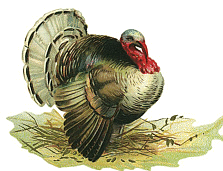
Abb.: Truthahn (©IMSI)
Audio: Truthahn
"Den altweltlichen Fasanen stehen in Amerika die Tuthühner (Unterfamilie Meleagridinae) gegenüber. Sehr große Hühnervögel mit metallglänzendem Gefieder und nacktem, rot und blau gefärbtem Kopf und Hals, an dem sich Hautfalten und Warzen befinden (beim Männchen stärker entwickelt als beim Weibchen, schwellen in der Erregung an); Männchen besitzt außerdem einen aufrichtbaren fleischigen Auswuchs an der Stirn. Schwanz 18fedrig, stark gerundet, mit breiten, am Ende leicht gerundeten oder geraden, wie abgeschnitten wirkenden Federn, die bei der Balz vom Männchen zu einem Rad aufgerichtet werden. Mauser der Schwanzfedern von außen nach innen (zentripetal). Schnabel verhältnismäßig kurz, aber schlank. Lauf lang, beim Männchen gespornt; beim Weibchen Sporen schwach entwickelt. Bodenvögel, die in Bäumen übernachten, Nahrung in erster Linie pflanzlich, doch werden auch viele Insekten und andere Kleintiere aufgenommen." [Skutch, Alexander F. -- In: Grzimeks Tierleben : Enzyklopädie des Tierreichs. -- Bd. 8: Vögel 2. -- Zürich : Kindler, ©1968. -- S. 19]
"Truthuhn (Meleagris gallopavo), schwerster Hühnervogel. Ausgewachsene Männchen 100 - 125 cm lang, wiegen bis 18 kg (in der freien Natur ausnahmsweise mehr als 11 kg); Weibchen beträchtlich kleiner. Gefieder dunkel, metallisch grün, gold, kupfern und bronzefarben glänzend; mit hellen und dunklen Binden gezeichnet. Raue und warzige nackte Kopf- und Halshaut blau und rot. Weicher fleischiger Stirnanhang ähnelt einem Horn, wenn er zusammenschrumpft, vergrößert sich aber bei der Balz; oft auch hängender Lappen am Vorderhals. Büschel langer, grober Borsten steht auffällig von der Brustmitte ab. Sieben Unterarten, in vielen Gebieten ausgerottet. Bewohnte im südlichen Teil seines Bereiches höhere Lagen (bis etwa 3350 m) als im Norden." [Skutch, Alexander F. -- In: Grzimeks Tierleben : Enzyklopädie des Tierreichs. -- Bd. 8: Vögel 2. -- Zürich : Kindler, ©1968. -- S. 19]
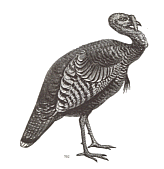
Abb.: Pute
Andere Namen für Truthühner: Puten, Indian, Pogern, Turkey (engl.)
"Truthühner oder Puten sind eine alte Hausgeflügelform, deren Domestikation in den indianischen Kulturen Mittel- und Nordamerikas erfolgte. Bald nach der Entdeckung Amerikas durch spanische Seefahrer am Ende des 15. Jh. gelangten die ersten Tiere dieses seltsamen, prunkvoll befiederten Hausgeflügels nach Europa. Man vermutet die ersten Importe bereits um 1500. Schriftstücke, die eindeutig den Transport von Truthühnern nach Spanien belegen, stammen aus den Jahren 1511 und 1512. Ein Dokument aus dem Jahre 1511, das vom Bischof von Valencia signiert ist, enthält den Befehl an alle Schiffe, jeweils 10 Truthühner für Sevilla mitzubringen. Da man glaubte, Westindien entdeckt zu haben, wurden die Truthühner von den Spaniern »Indische Hühner« genannt. Von Spanien aus breitete sich die Haltung dieses Hausgeflügels binnen kurzer Zeit über Europa aus: 1524 kamen sie nach England und um 1530 nach Deutschland. Einem Bericht des Konrad von Heresbach (16. Jh.) zufolge wurden um 1571 Puten bereits in größeren Herden am Niederrhein gehalten. Um die Mitte des 16. Jh. waren Truthühner auch in Skandinavien bekannt. Die eigentliche Herkunft dieses Hausgeflügels geriet jedoch bald in Vergessenheit. So kam es denn, dass die Engländer das Truthuhn als »turkey« (Türke) bezeichneten, und die alten Naturforscher in Europa das Truthuhn mit dem »meleagris« der antiken Schriftsteller, dem Perlhuhn, verwechselten, was sich im wissenschaftlichen Namen für das Truthuhn, Meleagris gallopavo Linne, 1758, niederschlug. ... Die ersten zu Beginn des 16. Jh. nach Europa eingeführten Truthühner gehen auf die in Zentralmexiko gehaltenen Hausbestände zurück. Als Stammform dieser Truthühner gilt die mexikanische Unterart des Wildtruthuhns, Meleagris gallopavo mexikana Gould, 1500."
[Benecke, Norbert <1954 - >: Der Mensch und seine Haustiere : die Geschichte einer jahrtausendealten Beziehung. -- Stuttgart : Theiss, ©1994. -- ISBN 3806211051. -- S. 392 - 393]
| Vorteile | Nachteile |
|---|---|
| The birds are efficient and generally take care of themselves. | Young birds are readily affected by temperature changes and must be protected from the sun as well as from sudden chills, such as may occur at night. They are particularly susceptible to dampness, especially if associated with cold. |
| They tolerate dry, hot, or cold climates and forage farther than chickens. | One peculiarity is the turkey's aversion to any change in feeding routine or the nature of the food. |
| They are large, fast growing, highly marketable, low in fat, and tasty. | Young turkeys are susceptible to parasitic infestation as well as to the same type of bacterial and virus diseases as chickens (for example, fowlpox and coccidiosis). Blackhead, a devastating disease of young turkeys, is carried by a common parasitic nematode, and can be contracted from chickens. Medicines are available to prevent or treat most disease and pest problems. |
[Microlivestock : little-known small animals with a promising economic future / Board on Science and Technology for International Development (BOSTID). -- Washington, DC : National Academy Press, Washington, 1991. -- [Darin: Pigeon, Quail, Turkey]. -- In: Humanity development library = HDL : for sustainable development and basic human needs. -- Version 2.0. -- Antwerp : Global Help Projects, 1998. -- 1 CD-ROM. -- {Sie können diese CD-ROM für 30$ hier bestellen: http://www.oneworld.org/globalprojects/humcdrom/order.htm}]
| Legebeginn | 34 Wochen | |
| Paarungsverhältnis | 1 Hahn für 10 Hennen | |
| Eizahl in einer Legeperiode | 90 - 125 Eier | |
| Eigewichte | 75 - 85 g | |
| Dauer der Legeperiode | 20 Wochen | |
| Wärmebedarf in der ersten Lebenswoche | 33 - 35°C | |
| Mastdauer | Weibchen: 14 - 16 Wochen |
Männchen: 22 - 26 Wochen |
| Futterverbrauch | 20 - 25 kg | 50 - 60 kg |
| Brutdauer | 28 Tage | |
| Unterbringung je m² Stallfläche | 1,5 - 2 Stück | |
| Auslauffläche je Tier | 50 m² | |
[Kennzahlen nach: Altrichter, Gerhard ; Braunsberger, Franz: Bäuerliche Geflügelhaltung : Produktion und Vermarktung von Eiern und Qualitätsgeflügel. -- 2., überarbeitete Aufl. -- Klosterneuburg : Österreichischer Agrarverlag, ©1997. -- ISBN 3704012254. -- S. 279 - 281. -- ]
In der folgenden Übersicht sind einzelne Länder nur aufgeführt, wenn ihr Putenbestand über 5 Mio. Tiere beträgt.
| Welt | 246 Mio. |
| Europa | 118 Mio. |
| USA und Kanada | 92 Mio. |
| Lateinamerika und Karibik | 16 Mio. |
| Asien | 12 Mio. |
| Afrika | 7 Mio. |
| Ozeanien | 12 Mio. |
| USA | 86 Mio. |
| Frankreich | 44 Mio. |
| Italien | 28 Mio. |
| Großbritannien | 12 Mio. |
| Brasilien | 9 Mio. |
| Deutschland | 7 Mio. |
| Portugal | 7 Mio. |
| Kanada | 6 Mio. |
[Quelle: FAOSTAT. -- URL: http://apps.fao.org/lim500/nph-wrap.pl?Production.Livestock.Stocks&Domain=SUA&servlet=1. -- Zugriff am 2000-03-30]
"The unimproved domestic turkey is essentially limited to central Mexico and scattered locations throughout nearby Latin American countries. Some village birds are also kept in India, Egypt, and other areas, but these are descended from semi-improved strains exported from North America and Europe in earlier times. Generally speaking, few turkeys are found in tropical countries outside Latin America. " "The turkey (Meleagris gallopavo) is well-known in North America and Europe, but in the rest of the world, especially in developing countries, its potential has been largely overlooked. Partly, this is because chickens are so familiar and grow so well that there seems no reason to consider any other poultry. Partly, it is because modern turkeys have been so highly bred for intensive production that the resulting birds are inappropriate for home production.
Nevertheless, there is a much wider potential role for turkeys in the future. There are types that thrive as village birds or as scavengers, but these are little known even to turkey specialists. These primitive types are probably the least studied of all domestic fowl; little effort has been directed at increasing their productivity under free-ranging conditions. However, they retain their ancestral self-reliance and are widely used by farmers in Mexico. That they are unrecognized elsewhere is a serious oversight.
Native to North America, the turkey was domesticated by Indians about 400 BC, and today's Mexican birds seem to be direct descendants. Unlike the large-breasted, modern commercial varieties, they mate naturally and they retain colored feathers and a narrow breast configuration. Their persistence in Mexico after 500 years of competition with other poultry highlights their adaptability, ruggedness, and usefulness to people. These birds complement chicken production. They are able to thrive under more arid conditions, they tolerate heat better, they range farther, and they have higher quality meat. Also, the percentage of edible meat is much greater than that from a chicken. Turkey meat is so low in fat that in the United States, at least, it is making strong inroads into markets that previously used chicken exclusively.
Turkeys are natural foragers and can be kept as scavengers. Indeed, they thrive best where they can rove about, feeding on seeds, fresh grass, other herbage, and insects. As long as drinking water is available, they will return to their roost in the evening.
Appreciation for the turkey could rise rapidly. Interest already has been shown by several African nations. A French company has created a strain of self-reliant farm turkeys and is exporting them to developing countries. Researchers in Mexico are displaying increased interest in their national resource. And as knowledge and breeding stock continue to be developed, it is likely that village turkeys will become increasingly popular around the world. "
[Microlivestock : little-known small animals with a promising economic future / Board on Science and Technology for International Development (BOSTID). -- Washington, DC : National Academy Press, Washington, 1991. -- [Darin: Pigeon, Quail, Turkey]. -- In: Humanity development library = HDL : for sustainable development and basic human needs. -- Version 2.0. -- Antwerp : Global Help Projects, 1998. -- 1 CD-ROM. -- {Sie können diese CD-ROM für 30$ hier bestellen: http://www.oneworld.org/globalprojects/humcdrom/order.htm}]
Truthühner gehören zwar zu den Hühnervögeln. Zwei wesentliche Unterschiede zu Hühnern im Verhalten sind:
Puten sind stressempfindlich. Stress kann zur Anfälligkeit für Krankheiten bzw. zu Verhaltensstörungen führen. Die wichtigsten stressauslösenden Faktoren sind:
Die wichtigsten Putenkrankheiten (in gemäßigten Klimaten) sind:
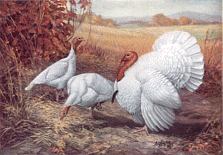
Abb.: Puten (©IMSI)
"In den folgenden Jahrhunderten gelang es, sechs Farbschläge herauszuzüchten:
- schwarze Norfolk-Blackpute,
- Cambridge-Bronzepute,
- weiße australische Pute,
- Jersey-Buff-Pute,
- schieferfarbene Pute und
- belgische Ronquierres-Pute,
auf denen die weiteren Züchtungen aufbauten. Daneben wurde die Körpermasse auf züchterischem Wege bedeutend gesteigert. Puten werden heute ausschließlich für die Fleischproduktion gehalten. Schwere Putenformen, zu denen die Bronzefarbige Pute gehört, erreichen in der Körpermasse bei den Hähnen 10- 15 kg und bei den Hennen 6 - 8 kg. Da es bei der Wirtschaftspute auf eine maximale Fleischausbeute bei geringstem Futteraufwand ankommt, konzentriert sich das züchterische Interesse heute auf breitbrüstige Putenschläge. Die Produktion von Putenfleisch hat vor allem in den USA, in Italien, Großbritannien und Frankreich eine große wirtschaftliche Bedeutung."
[Benecke, Norbert <1954 - >: Der Mensch und seine Haustiere : die Geschichte einer jahrtausendealten Beziehung. -- Stuttgart : Theiss, ©1994. -- ISBN 3806211051. -- S. 394]
"Modern turkey breeding has been so dominated by selection for increased size and muscling that commercial turkeys have leg problems and cannot mate naturally (they are inseminated artificially). These highly bred birds are adapted for large-volume intensive production, and must be raised with care. As noted, this chapter emphasizes the more self-reliant, less highly selected turkeys found in Mexico and a few other Latin American countries. They do not require artificial insemination, and with little attention can care for themselves and their young. Fully grown "criollo" turkeys of Mexico are less than half the size of some improved strains. Males weigh between 5 and 8 kg; females, between 3 and 4 kg. They vary in color from white, through splashed or mottled, to black. The skin of the neck and head is bare, rough, warty, and blue and red in color. A soft fleshy protuberance at the forehead (the snood) resembles a finger. In males it swells during courtship. The front of the neck is a pendant wattle. A bundle of long, coarse bristles (the beard) stands out prominently from the center of the breast. "
[Microlivestock : little-known small animals with a promising economic future / Board on Science and Technology for International Development (BOSTID). -- Washington, DC : National Academy Press, Washington, 1991. -- [Darin: Pigeon, Quail, Turkey]. -- In: Humanity development library = HDL : for sustainable development and basic human needs. -- Version 2.0. -- Antwerp : Global Help Projects, 1998. -- 1 CD-ROM. -- {Sie können diese CD-ROM für 30$ hier bestellen: http://www.oneworld.org/globalprojects/humcdrom/order.htm}]
"The ocellated turkey (Agriocharis ocellata) occurs in Yucatan, Guatemala, and Belize. It is much like the common turkey in size, form, and behavior: however, unlike the common turkey, which in Mexico lives in the high mountain pine and oak forests, the ocellated turkey inhabits bushy, semiforested lowlands. This splendid bird lacks the kind of beard sported by the common turkey gobbler, is generally more metallic in appearance, and has brighter coppery colors. The chief character is a neck and head that are bare, blue, and profusely covered with coral-colored pimples. It also has a yellow-tipped protuberance growing on the crown between the eyes. This species is worthy of investigation by poultry researchers because it might prove to be domesticable. It was possibly domesticated by the Mayas, whose ruins often include appropriately sized stone enclosures whose soil has elevated levels of phosphorus and potassium. Even today, in the rural Peten area of Guatemala, ocellated turkeys are sometimes kept around houses as scavengers. "
[Microlivestock : little-known small animals with a promising economic future / Board on Science and Technology for International Development (BOSTID). -- Washington, DC : National Academy Press, Washington, 1991. -- [Darin: Pigeon, Quail, Turkey]. -- In: Humanity development library = HDL : for sustainable development and basic human needs. -- Version 2.0. -- Antwerp : Global Help Projects, 1998. -- 1 CD-ROM. -- {Sie können diese CD-ROM für 30$ hier bestellen: http://www.oneworld.org/globalprojects/humcdrom/order.htm}]
[Zitate: Altrichter, Gerhard ; Braunsberger, Franz: Bäuerliche Geflügelhaltung : Produktion und Vermarktung von Eiern und Qualitätsgeflügel. -- 2., überarbeitete Aufl. -- Klosterneuburg : Österreichischer Agrarverlag, ©1997. -- ISBN 3704012254. -- S. 91 - 94. -- ]
"These birds are raised almost exclusively for meat. In many countries, they are a treat for holidays, birthdays, and weddings. In their native range of Mexico and Central America, the "unimproved" birds are usually produced as a cash crop for market. They receive little care or feed, and thus they are almost all profit - providing a significant income supplement to many rural homes. "
[Microlivestock : little-known small animals with a promising economic future / Board on Science and Technology for International Development (BOSTID). -- Washington, DC : National Academy Press, Washington, 1991. -- [Darin: Pigeon, Quail, Turkey]. -- In: Humanity development library = HDL : for sustainable development and basic human needs. -- Version 2.0. -- Antwerp : Global Help Projects, 1998. -- 1 CD-ROM. -- {Sie können diese CD-ROM für 30$ hier bestellen: http://www.oneworld.org/globalprojects/humcdrom/order.htm}]
Man unterscheidet bei Putenfleisch folgende Geflügelteile
Audio: Taubengegurre
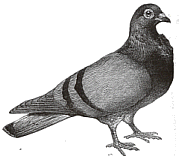
Abb.: Haustaube
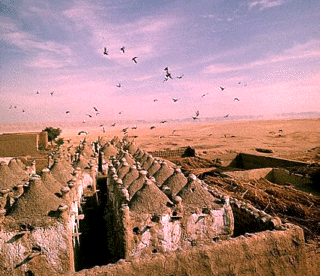
Abb.: "Doves roost on dovecotes with mud walls and domed
roofs. The structures incorporate ceramic vessels upturned or turned on their
side to provide nesting locations. Beyond is the desert plain surrounding the
village of El Til, at the site of ancient Akhetaten. Egypt, November 1962"
(©Corbis)
"Die Taube ist ein altes Hausgeflügel mit heute weltweiter Verbreitung. Im Vordergrund der Taubenhaltung steht der Taubensport, d.h. die Züchtung von
- Rassetauben,
- Brieftauben,
- Tümmlern und
- sonstigen Flugsporttauben.
In ihrer Eigenschaft als Hobbyhaustier sind vielfältige, teilweise ungewöhnliche Gestalten und Fähigkeiten bei Haustauben herausgezüchtet worden. Tauben gehören damit zu den Haustieren, die eine breite Rassebildung aufweisen. Von jeher besitzen Tauben auch einen wirtschaftlichen Aspekt. Von ihren Produkten, Fleisch, Federn und Dung, hat heute nur noch das Fleisch eine gewisse Bedeutung. Es ist zart, leicht verdaulich und enthält im Vergleich zu anderen Fleischarten reichlich Eiweiß und Mineralstoffe, jedoch verhältnismäßig wenig Fett. Diese Eigenschaften erklären seine diätetische Wirkung.
Die Abstammung der Haustaube von der Felsentaube (Columba livia Gmelin, 1789) konnte bereits Ch. Darwin (1809 - 1882) durch Kreuzungsexperimente mit verschiedenen Haustaubenrassen nachweisen."
[Benecke, Norbert <1954 - >: Der Mensch und seine Haustiere : die Geschichte einer jahrtausendealten Beziehung. -- Stuttgart : Theiss, ©1994. -- ISBN 3806211051. -- S. 383]
"Pigeons (Columba livia) are durable birds that can be raised with little effort. Able to survive in inhospitable climates, they fend for themselves -- often ranging over many square kilometers to locate seeds and edible scraps. They have been raised for centuries, especially in North Africa and the Middle East. In parts of North America and Europe, they are produced as a delicacy for the gourmet market. But raising pigeons for food is not nearly as widespread as it could be; indeed, in modern times its potential has hardly been touched. Farmed pigeons are particularly promising as urban microlivestock because they require little space and thrive in cities. Young pigeons (squab) grow at a rapid rate. Their meat is finely textured, has an attractive flavor, and is often used in place of game fowl. Tender and easily digested, it commands premium market prices. In many areas, the continuing demand is unfilled.
Pigeons are traditionally raised in dovecotes -- "houses" that protect the birds from the elements and from predators. This system allows free-ranging flight and requires almost no human intervention. Dovecotes are a good source of both squab and garden manure, and they continue to be used, especially in Egypt. On the other hand, pigeons can also be raised in confinement -- usually in enclosed yards -- with all their needs supplied by the farmer. There are, for example, pigeon farms in the United States with up to 35,000 pairs of breeding birds.
Pigeon production may never rise enough to compete with commercial poultry as a major source of food, but for Third World villages these birds could become a significant addition to the diet as well as a source for substantial supplemental income."
[Microlivestock : little-known small animals with a promising economic future / Board on Science and Technology for International Development (BOSTID). -- Washington, DC : National Academy Press, Washington, 1991. -- [Darin: Pigeon, Quail, Turkey]. -- In: Humanity development library = HDL : for sustainable development and basic human needs. -- Version 2.0. -- Antwerp : Global Help Projects, 1998. -- 1 CD-ROM. -- {Sie können diese CD-ROM für 30$ hier bestellen: http://www.oneworld.org/globalprojects/humcdrom/order.htm}]
| Vorteile | Nachteile |
|---|---|
| Under extensive conditions -- where the birds are released each day to feed themselves -- almost no land is needed. Under intensive conditions, where the birds spend their lives in confinement, a mere half hectare can be enough space to raise 2,000 pairs. | Pigeons are subject to few diseases. However, worms, lice, diarrhea (coccidiosis), canker (trichomoniasis), and salmonella (paratyphoid) occur at some time in most domestic breeds. Salmonella exists in low levels in most flocks and will flare up if birds are stressed. Treatments recommended for domestic chickens are usually suitable for pigeons. |
| Free-ranging pigeons forage over a wider area than most domestic fowl because they fly out to find their feed. Nutrient requirements3 are similar to those of chickens and other fowl (making allowance for the energy needed for flying), so commercial feed and other supplements - if needed at all - are generally available. | By flying over a wide area and eating grains and other foods, pigeons can cause conflicts with farmers. Indeed, in the 13th century the aristocracy's pigeons became a major grievance of the peasants who saw their seed devoured. On the other hand, "croppers" (breeds with large crops) were developed to steal grain from the lord's fields. The pigeon returned home and his crop was emptied of the grain, which was used by the peasant to make bread. |
| In dovecote culture, pigeons require little or no handling. They brood the young with little intervention. Although not continuous, the production of meat from these fast-growing, rapidly reproducing birds is more sustained than with most livestock. | The birds can become nuisances. They leave droppings in annoying places, some people find them too noisy, and a few people are severely allergic to "pigeon dust." |
| Almost nowhere are there taboos against consuming pigeon meat. Prices received for squab are normally high, and in most places the demand is constant. The only limitation in some areas is the absence of an effective market, which is usually easy to create. | Every conceivable type of predator can be expected; therefore, precautions must be taken. The dovecote must be well protected against rats, which are the principal enemy of the eggs and the squabs. |
| Squab contains a larger proportion of soluble protein and a smaller proportion of connective tissue than most meats and is therefore good for invalids and people with digestive disorders. | Nesting birds need a high-protein diet to raise squab at the high rates of gain that are possible. |
| As many hobbyists can testify, raising pigeons can be gratifying. |
[Microlivestock : little-known small animals with a promising economic future / Board on Science and Technology for International Development (BOSTID). -- Washington, DC : National Academy Press, Washington, 1991. -- [Darin: Pigeon, Quail, Turkey]. -- In: Humanity development library = HDL : for sustainable development and basic human needs. -- Version 2.0. -- Antwerp : Global Help Projects, 1998. -- 1 CD-ROM. -- {Sie können diese CD-ROM für 30$ hier bestellen: http://www.oneworld.org/globalprojects/humcdrom/order.htm}]
"Die Taube gehört zu den Tieren, die im Hausstand eine große Formenfülle erreicht haben. Die Anzahl der heute gehaltenen Taubenrassen schätzt man auf über 350. Sie lassen sich grob in
- Sporttauben,
- Formen- und Farbentauben, die hauptsächlich Schauzwecken dienen, und
- Wirtschaftstauben gliedern.
Zu den bekanntesten Sporttaubenrassen zählen vor allem die Brieftauben. Sie werden ausschließlich auf Orientierungsvermögen, Schnelligkeit und Ausdauer gezüchtet. ...
Im Vergleich zu den Ausstellungstauben ist die Zahl der Wirtschafts- oder Masttaubenrassen gering. Für die Fleischerzeugung werden u. a. solche Rassen wie
- Römer,
- Ungarische Riesentauben,
- Strasser,
- Coburger Lerchen,
- Malteser und
- Weiße Wirtschaftstauben
genutzt. In neuerer Zeit haben sich in der Fleischtaubenproduktion vor allem Rassen wie
- Giant Homer,
- Carneaux,
- King,
- Texan und
- Texan-Pioneer
durchgesetzt. Die Fleischnutzung von Tauben unter industriemäßigen Bedingungen hat vor allem in Ländern Bedeutung, die dafür billiges Futter verwenden können (USA, Frankreich, Ungarn u. a.)."
[Benecke, Norbert <1954 - >: Der Mensch und seine Haustiere : die Geschichte einer jahrtausendealten Beziehung. -- Stuttgart : Theiss, ©1994. -- ISBN 3806211051. -- S. 389 - 390]
|
Zuchttiere:
Haltung:
Brut und Aufzucht
[Angaben nach: Jahrbuch für die Geflügelwirtschaft : Jahrbuch des
Zentralverbandes der Deutschen Geflügelwirtschaft e.V. und seiner
Mitgliedverbände. -- Stuttgart : Ulmer. -- ISSN 0447-2713 |
Brieftauben können in Entwicklungsländern weit mehr als nur ein Hobby sein: "This system has been employed in Puerto Rico and Guatemala, but it could be used almost anywhere. In many parts of the Third World, in particular, there are remote areas with no phones and with hilly, rough terrain where delivering messages can take hours of strenuous travel. Some locations are subject to unexpected isolation by natural calamities or military or terrorist actions.
In Puerto Rico, for instance, we kept pigeons in a village 32 km from the capital. The pigeons could get downtown in 20-30 minutes. It took us 1.5 - 2 hours each way by road. What was easy for the birds was a major trip for us. Pigeons carried the villagers' requests for certain foods and medicines. Our contact in the city then sent up the supplies by bus. The birds never let us down. "
[Englischsprachige Zitate aus: Microlivestock : little-known small animals with a promising economic future / Board on Science and Technology for International Development (BOSTID). -- Washington, DC : National Academy Press, Washington, 1991. -- [Darin: Pigeon, Quail, Turkey]. -- In: Humanity development library = HDL : for sustainable development and basic human needs. -- Version 2.0. -- Antwerp : Global Help Projects, 1998. -- 1 CD-ROM. -- {Sie können diese CD-ROM für 30$ hier bestellen: http://www.oneworld.org/globalprojects/humcdrom/order.htm}]

Abb.: Wachtel
|
[Angaben nach: Jahrbuch für die Geflügelwirtschaft : Jahrbuch des
Zentralverbandes der Deutschen Geflügelwirtschaft e.V. und seiner
Mitgliedverbände. -- Stuttgart : Ulmer. -- ISSN 0447-2713
[Jahrgang] 2000. -- ©1999. -- ISBN 3800138042. -- S. 130]
"Aus der Gruppe der Wachteln, die zu den Hühnervögeln gehören, wird die Japanische Wachtel als Hausgeflügel gehalten. Die Wildform ist die Wachtel (Coturnix coturnix Linne, 1758), deren Verbreitungsgebiet Eurasien, Nordwest- und Südafrika sowie Madagaskar umfasst. In diesem großen Areal leben mehrere Unterarten. Die Japanische Wachtel ist aus der in Ostasien lebenden Unterart Coturnix coturnix japonica Temminck und Schlegel, 1844 hervorgegangen.... Die Domestikation der Wachtel lässt sich auf der Grundlage schriftlicher Quellen bis in das 13. Jh. zurückverfolgen. In jener Zeit wurden Wachteln als Singvögel gehalten und gezüchtet. Unklar ist, ob die Domestikation dieser Tiere in Japan erfolgte oder ob man bereits domestizierte Wachteln aus China oder Korea eingeführt hatte.
Die enorme Legeleistung der Japanischen Wachtel wurde erst im 20. Jh. herausgezüchtet. Die Eiablage beginnt bei den Junghennen etwa im Alter von 50 Tagen. Wachtelhennen werden in der Regel nur 8 -12 Monate lang gehalten, weil in dieser Zeit ihre Legetätigkeit am intensivsten ist. Unter natürlichen Bedingungen und ohne Kunstbeleuchtung legt die Wachtelhenne von März bis Ende August etwa 100 Eier, um danach zwei Monate zu mausern. Bei entsprechender Intensivhaltung sind Legeleistungen von 250 bis 300 Eiern jährlich erreicht worden. Die Produktion von Wachteleiern in Japan ist gewaltig. Allein die Betriebe der Halbmillionenstadt Toyohashi produzieren heute täglich etwa 1,3 Millionen Eier, die im frischen und gekochten Zustand verkauft werden. Spezialbetriebe halten in der Regel etwa 20 000 - 30 000 Tiere. Neben der Zucht auf Legeleistung werden Wachteln auch gemästet. Als Ergebnis der Züchtung sind seit den 60er Jahren Masttypen entstanden, die rund 50% höhere Lebendmassen als die Legewachteln erreichen. Seit Mitte der 50er Jahre spielt die Zucht der Japanwachtel auch in Europa, vor allein in Frankreich, Italien, England und Ungarn, eine gewisse Rolle. In den USA, in Großbritannien und in Deutschland wird die japanische Wachtel daneben in zunehmendem Maße als Versuchstier für die Wissenschaft eingesetzt."
[Benecke, Norbert <1954 - >: Der Mensch und seine Haustiere : die Geschichte einer jahrtausendealten Beziehung. -- Stuttgart : Theiss, ©1994. -- ISBN 3806211051. -- S. 396 - 398]
"Native to Asia and Europe, quail' (Coturnix coturnix) have been farmed since ancient times, especially in the Far East. They reproduce rapidly and their rate of egg production is remarkable. They are also robust, disease resistant, and easy to keep, requiring only simple cages and equipment and little space. Yet they are not well known around the world and deserve wider testing. ... Many of the domesticated strains seem to have originated in China, and migrating Chinese carried them throughout Asia. Today, millions of domestic quail are reared in Japan, Indonesia, Thailand, Taiwan, Hong Kong, Indochina, Philippines, and Malaysia, as well as in Brazil and Chile.
Commercial production is carried out, as in the chicken industry, in specialized units involving hatcheries, farms, and factories that process eggs and meat. However, quail have outstanding potential for village and "backyard" production as well. It is this aspect that deserves greater attention. "
"A quail's diet in the wild consists of insects, grain, and various other seeds. To thrive and reproduce efficiently in captivity, it needs feeds that are relatively high in protein. "
Vor- und Nachteile der Wachtelhaltung Vorteile Nachteile Quail production can be started with little money. These easy-care birds can be housed in small, simple, inexpensive cages. Quail seem to require more protein than chickens, and produce best when given feed that is fairly high in protein. However, they also perform satisfactorily when fed rations designed for turkeys. They have high requirements for vitamin A, which they do not store. They are resistant to Newcastle disease. Although generally disease resistant, quail are affected by several common poultry diseases, including salmonella, cholera, blackhead, and lice. They also suffer epidemic mortality from "quail disease" (ulcerative enteritis), which can, however, be controlled with antibiotics. Quail are not suitable as free-ranging "scavengers." They must be kept confined, which is a major constraint. Unlike chickens or pigeons, they have no homing instinct and will not remain on a given site; if released, they will be lost. In addition, since they nest on the ground, they are highly susceptible to predation; they must be protected, especially where certain animals, the mongoose for example, are common. Artificial incubation is essential. Natural incubation using the female is futile; the females do not go broody and rarely incubate their eggs. The shells are extremely thin, but the eggs can be incubated under a small chicken hen, such as a bantam. The eggs are also subject to minute fractures. However, the shell membrane is extremely tough and unfertilized eggs are generally unaffected, but the cracks cause fertilized embryos to dehydrate and die. This is a serious limitation. Whenever quail husbandry is introduced, artificial incubation should be included. [Microlivestock : little-known small animals with a promising economic future / Board on Science and Technology for International Development (BOSTID). -- Washington, DC : National Academy Press, Washington, 1991. -- [Darin: Pigeon, Quail, Turkey]. -- In: Humanity development library = HDL : for sustainable development and basic human needs. -- Version 2.0. -- Antwerp : Global Help Projects, 1998. -- 1 CD-ROM. -- {Sie können diese CD-ROM für 30$ hier bestellen: http://www.oneworld.org/globalprojects/humcdrom/order.htm}]
"The fact that chickens can be crossed with quail has been known for some time, but there has been little attempt to develop the fertile hybrids. Now Malaysia has begun a project aimed at producing a new poultry bird - a cross between a cockerel and a hen quail. Zainal Abidin bin Mohd Noor, of the Department of Veterinary Services in Kuala Lumpur, is creating a strain that produces eggs of good quality and meat with the flavor of both parents. The new bird is intermediate in size between chicken and quail which is convenient because it is about right for an individual helping. The crossbreeding is done through artificial insemination. The progeny exhibit a range of appearances, sizes, and plumage colors, depending on the strains of cockerel and quail hens used. In the Malaysian research, cockerels have been local Ayam Kampung Bantam, Hybro, and Golden Comet hybrids. The quails have been local inbred Japanese quail (IJQ) and imported meat strain quail (IMSQ).
The trials show that the hybrids derived from the IMSQ flocks grew faster and bigger than those from the IJQ cross. The best have been the Hybro x IMSQ crosses, which weigh 475 g at 10 weeks of age. The best of the IJQ group weighed 290 g during the same period.
This type of "tropical game hen" might be a way to introduce hybrid vigor into poultry production.
The researchers who developed the hybrid have named it the yamyuh. "
[Microlivestock : little-known small animals with a promising economic future / Board on Science and Technology for International Development (BOSTID). -- Washington, DC : National Academy Press, Washington, 1991. -- [Darin: Pigeon, Quail, Turkey]. -- In: Humanity development library = HDL : for sustainable development and basic human needs. -- Version 2.0. -- Antwerp : Global Help Projects, 1998. -- 1 CD-ROM. -- {Sie können diese CD-ROM für 30$ hier bestellen: http://www.oneworld.org/globalprojects/humcdrom/order.htm}]
"Dozens of wild quail species and subspecies occupy many different habitats and ecological niches in almost all parts of the world. Out of all this genetic wealth only one species - the Japanese quail - is widely used. Yet many other species seem easy to raise, becoming exceedingly tame after about the sixth generation. The management and even perhaps intensive production of these various local quails might provide long-term benefits for many developing nations. Quail meat ranks among the finest.14 Some of these lesser-studied birds are more meaty than the Japanese quail or have other possibly useful traits. Much is known about rearing a few of them because they are used in sport hunting or laboratory research. The possibility of domestication, therefore, is not farfetched.
Particular quail that might be considered for domestication are the lesser-known subspecies of Coturnix coturnix. These subspecies are found in various places, including the following:
- Europe (Coturnix coturnix coturnix breeds in the area ranging from northern Russia to North Africa and from the British Isles to Siberia. In winter it migrates to tropical Africa, Asia, and southern India.)
- The Azores (Coturnix coturnix conturbans)
- The Azores, Madeira, and the Canary Islands (Coturnix coturnix confisa)
- Cape Verde Islands (Coturnix coturnix inopinata)
- East Africa (Coturnix coturnix erlangeri)
- Tropical Africa, southern Africa, Madagascar, and Mauritius (Coturnix coturnix africana)
- Japan (Coturnix coturnix japonica, the most probable ancestor of the domesticated quail)
- China (Coturnix coturnix ussuriensis, a possible ancestor of the domesticated Japanese quail)"
[Microlivestock : little-known small animals with a promising economic future / Board on Science and Technology for International Development (BOSTID). -- Washington, DC : National Academy Press, Washington, 1991. -- [Darin: Potential new poultry]. -- In: Humanity development library = HDL : for sustainable development and basic human needs. -- Version 2.0. -- Antwerp : Global Help Projects, 1998. -- 1 CD-ROM. -- {Sie können diese CD-ROM für 30$ hier bestellen: http://www.oneworld.org/globalprojects/humcdrom/order.htm}]
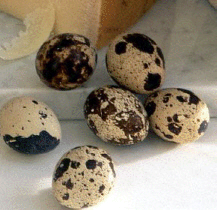
Abb.: Gekochte Wachteleier (©Corbis)
[Englischsprachige Zitate: Microlivestock : little-known small animals with a promising economic future / Board on Science and Technology for International Development (BOSTID). -- Washington, DC : National Academy Press, Washington, 1991. -- [Darin: Pigeon, Quail, Turkey]. -- In: Humanity development library = HDL : for sustainable development and basic human needs. -- Version 2.0. -- Antwerp : Global Help Projects, 1998. -- 1 CD-ROM. -- {Sie können diese CD-ROM für 30$ hier bestellen: http://www.oneworld.org/globalprojects/humcdrom/order.htm}]
|
|
|
|
| "Vögel sind Flugwesen, und die meisten ihrer körperlichen Besonderheiten lassen sich nur im Zusammenhang mit ihrem Flugvermögen verstehen. Es gibt jedoch auch flugunfähige Vögel, unter denen die
Laufvögel (Ordnung Struthioniformes) die bekannteste und wichtigste Gruppe bilden. Sie sind in manchen ihrer Merkmale urtümlicher als die meisten anderen heute lebenden Vögel. Deshalb vermutete man früher, die Laufvögel könnten sich schon vom übrigen Vogelstamm abgespalten haben, zu einer Zeit, in der die Vögel das Fliegen noch nicht »erfunden« hatten. Wenn das jedoch zuträfe, wären viele Körpermerkmale der Laufvögel unverständlich. Sie alle haben ein Flügelskelett, das sich nicht grundsätzlich von dem flugfähiger Vögel unterscheidet. Ihre Flügel tragen noch Schwung- und Deckfedern; sie sind verkümmerte Flugwerkzeuge und nicht etwa verkümmerte Vorderbeine, wie das bei zweifüßig gehenden Dinosauriern der Fall ist. Die Laufvögel stammen also zweifellos von flugfähigen Ahnen ab und haben das Flugvermögen offenbar im Zusammenhang mit ihrer zunehmenden Körpergröße verloren. Das führte zu einer erheblichen Umbildung von Knochen, Muskeln und Gefieder: Brustmuskeln verkümmert, Brustbeinkamm rückgebildet, Schlüsselbeine fast völlig verschwunden, Flügelskelett und Flügelmuskulatur vereinfacht. Schwung- und Steuerfedern rückgebildet oder zu Schmuckfedern umgebildet. Beine kräftig, Beinknochen außer Oberschenkel nicht mehr lufthaltig. Keine Abgrenzung von Federfluren und Federrainen; Schwund der Federfahnen, Einfetten des Gefieders deshalb entbehrlich, Bürzeldrüse fehlt." [Grzimeks Tierleben : Enzyklopädie des Tierreichs. -- Bd. 7: Vögel 1. -- Zürich : Kindler, ©1968. -- S. 85] |
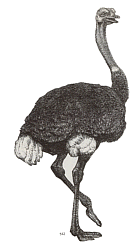
Abb.: Strauß
"Obgleich der Strauß erst seit der Mitte des 19. Jh. planmäßig gezüchtet wird, und damit ein verhältnismäßig junges Hausgeflügel ist, lässt sich seine Nutzung durch den Menschen bis in die Zeit der vorderorientalischen Stromtalkulturen zurückverfolgen. Der Strauß (Struthio camelus Linne, 1755) kommt heute nur noch in den Steppen und Savannen Afrikas vor. Früher reichte sein Verbreitungsgebiet bis nach Zentralasien. Der Straußenhahn ist mit einer Größe von 2,50 m und einer Körperrnasse von 100 bis 130 kg der größte Vogel der Erde. In seinem offenen Lebensraum ist er zu einem ausgesprochenen Laufvogel geworden, dem die langen kräftigen Beine Sätze von vier Metern Weite und eine Laufgeschwindigkeit von bis zu 50 km/h erlauben. Strauße sind flugunfähige Vögel, die in Herden von 10 bis 50 Tieren zusammenleben. Die Hähne scharen meist drei Hennen um sich. Die bis zu 20 cm langen, oft mehr als 1,5 kg schweren Eier legen die Hennen in eine gemeinsame Nestmulde. Das Gelege einer Henne umfasst etwa 15 Eier. Gefangen gehaltene Strauße können dagegen bis zu 90 Eier legen, wenn ihnen diese ständig aus der Nestmulde entfernt werden. Die Brutzeit beträgt etwa 45 Tage. Gelegentlich bedeckt der Strauß die Eier mit einer Sandschicht und überlässt die Bebrütung der Sonne. ...
Gelegentlich wurden Strauße geritten oder vor kleine Wagen gespannt. So ließ sich Ptolemaios II. (308 - 246 v. Chr.) bei einem großen Festumzug in einem Wagen von acht Straußen ziehen, während seine Gemahlin auf einem Strauß ritt. Da die Vögel aber kaum einen ausgewachsenen Reiter tragen können, wird es sich hier nur um gelegentliche Schaustellungen gehandelt haben. Auch vom Mästen der Strauße für die festliche Tafel wird berichtet. Diese Nutzungsform erscheint aus heutiger Sicht unverständlich, da Straußenfleisch wenig schmackhaft sein soll. Im Mittelalter schmückten Straußenfedern die Helme der Ritter. In der zweiten Hälfte des 18. Jh. setzten sich Straußenfedern dann als Modeschmuck in Frankreich durch. Etwa zur selben Zeit begann man in Südafrika mit der Haltung von Straußen, deren Federn alle 2 - 3 Jahre für den Verkauf geschnitten wurden. Die in Europa verkauften Straußenfedern stammten jedoch noch bis in die erste Hälfte des 19. Jh. von in Nordafrika und Arabien erlegten Wildstraußen.
Mit dem wachsenden Bedarf an Federn für die Modeindustrie und dem Rückgang der Strauße in freier Wildbahn in der Mitte des 19. Jh. setzte die farmmäßige Haltung dieses Vogels in verschiedenen Ländern ein, womit die Domestikation des Straußes eingeleitet war. Straußenfarmen errichtete man auch außerhalb Afrikas, so in Asien, Australien sowie in Nord- und Südamerika. Der Zusammenbruch des Federhandels im Jahre 1914 führte zum Ruin vieler Farnen. Allein in Südafrika hielt sich die Farmhaltung von Straußen bis in die Gegenwart. Der Bestand beläuft sich heute auf mehrere hunderttausend Vögel. In der kurzen Zeit seit dem Domestikationsbeginn sind mehrere Schläge herausgezüchtet worden. Die Feder ist nach wie vor das wichtigste Exportprodukt der Straußenfarmen."
[Benecke, Norbert <1954 - >: Der Mensch und seine Haustiere : die Geschichte einer jahrtausendealten Beziehung. -- Stuttgart : Theiss, ©1994. -- ISBN 3806211051. -- S. 398 - 399]
Ähnlich wie Strauße hält man auch australische Emus (Dromeniceus novaehollandiae).
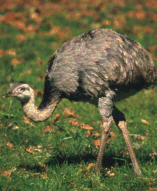
Abb.: Emu (©ArtToday™)
"Durch die Einfuhr von Straußen und Emus mussten sich die Rancher mit einer völlig neuen Art der Tierhaltung vertraut machen. Strauße und Emus baden gerne im Sand, und die männlichen Strauße geben einen ungewohnten Ruf von sich, der wie das Brüllen eines Löwen mit einem gleichzeitigen Zischen klingt. Sie erreichen Geschwindigkeiten von bis zu 60 km/h und treten wild und kräftig um sich, wenn sie angegriffen werden, so dass es mitunter schwierig ist, sie zusammenzutreiben. Jeder Hahn scharrt eine flache Mulde in den Sand, und drei bis vier Hennen legen ihre Eier in dieses Gemeinschaftsnest. Jede Henne legt bis zu 10 Eiern, die fünf bis sechs Wochen lang bebrütet werden. Nachts sitzt der Hahn auf dem Gelege. Die riesigen Vögel können ein Alter von bis zu 70 Jahren erreichen, so dass ihre Haltung und Zucht eine Lebensaufgabe darstellt." [Danforth, Randi ; Feierabend, Peter ; Chassman, Gary: Culinaria USA : eine kulinarische Entdeckungsreise. -- Köln : Könemann, ©1999. -- (Culinaria). -- ISBN 3829002580. -- S. 188.]
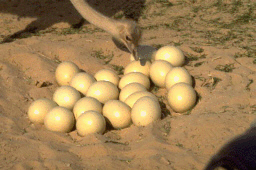
Abb.: Strauß mit Eiern, Israel, 1993(©Corbis)
|
Abb.: G/wi-Buschmann verziert Straußenei und markiert diesen Wasserbehälter so als seinen Besitz, Kalahari-Wüste, Botswana (©Corbis) |
Abb.: Verzierte Wasserbehälter aus Straußeneiern, G/wi-Buschmänner, Kalahari-Wüste, Botswana (©Corbis) |
|
Abb.: G/wi-Buschmann saugt Wasser aus trockenem Flussbett in Straußenei als Wasserbehälter, Kalahari-Wüste, Botswana (©Corbis) |
Abb.: G/wi-Buschfrau mit mit Wasser gefüllten Straußeneiern, Kalahari-Wüste, Namibia (©Corbis) |
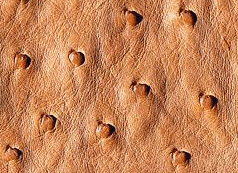
Abb.: Straußenleder (©Corbis)
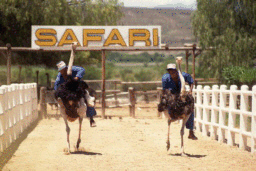
Abb.: Straußenrennen auf Straussenfarm, Südafrika, 1996 (©Corbis)
Altrichter, Gerhard ; Braunsberger, Franz: Bäuerliche Geflügelhaltung : Produktion und Vermarktung von Eiern und Qualitätsgeflügel. -- 2., überarbeitete Aufl. -- Klosterneuburg : Österreichischer Agrarverlag, ©1997. -- 288 S. : Ill. -- ISBN 3704012254. -- . -- [Enthält Kapitel über Hühner, Truthühner, Perlhühner, Wachteln, Enten, Gänse, Tauben. Empfehlenswert]
Feldhaus, Ludger ; Sieverding, Erwin: Putenmast. -- Stuttgart : Ulmer, ©1995. -- 85 S. : Ill. -- ISBN 3800145340. --
Humanity development library = HDL : for sustainable development and basic human needs. -- Version 2.0. -- Antwerp : Global Help Projects, 1998. -- 1 CD-ROM. -- [Enthält 800 Bücher, Reports und Broschüren sowie 430 Zeitschriften, insgesamt ca. 160.000 S. von Publikationen von mehr als100 Organisationen (z.B. FAO, gtz, Oxfam, Peace Corps, SKAT, UNESCO, UNICEF, WHO, World Bank); unentbehrlich!]. -- {Sie können diese CD-ROM für 30$ hier bestellen: http://www.oneworld.org/globalprojects/humcdrom/order.htm}. -- Online zugänglich: URL: http://media.payson.tulane.edu:8083/. -- Zugriff am 27.4.2000
Darin u.a.:
- Microlivestock : little-known small animals with a promising economic future / Board on Science and Technology for International Development (BOSTID). -- Washington, DC : National Academy Press, Washington, 1991. -- [Darin: Pigeon, Quail, Turkey]
Jahrbuch für die Geflügelwirtschaft : Jahrbuch des Zentralverbandes der Deutschen Geflügelwirtschaft e.V. und seiner Mitgliedverbände. -- Stuttgart : Ulmer. -- ISSN 0447-2713
[Jahrgang] 2000. -- ©1999. -- ISBN 3800138042Nutztiere der Tropen und Subtropen / Hrsg. Siegfried Legel. -- Stuttgart [u.a.] : Hirzel.. -- Bd. 3: Pferde/Esel, Schweine, Elefanten, Geflügel, Bienen, Seidenspinner. -- ©1993. -- ISBN 3777604976
Woernle, Hellmut: Geflügelkrankheiten. -- Stuttgart : Ulmer, ©1994. -- 128 S. : Ill. -- (Patient Tier). -- ISBN 3800172909. --
Zu Kapitel 8.8: Kaninchen